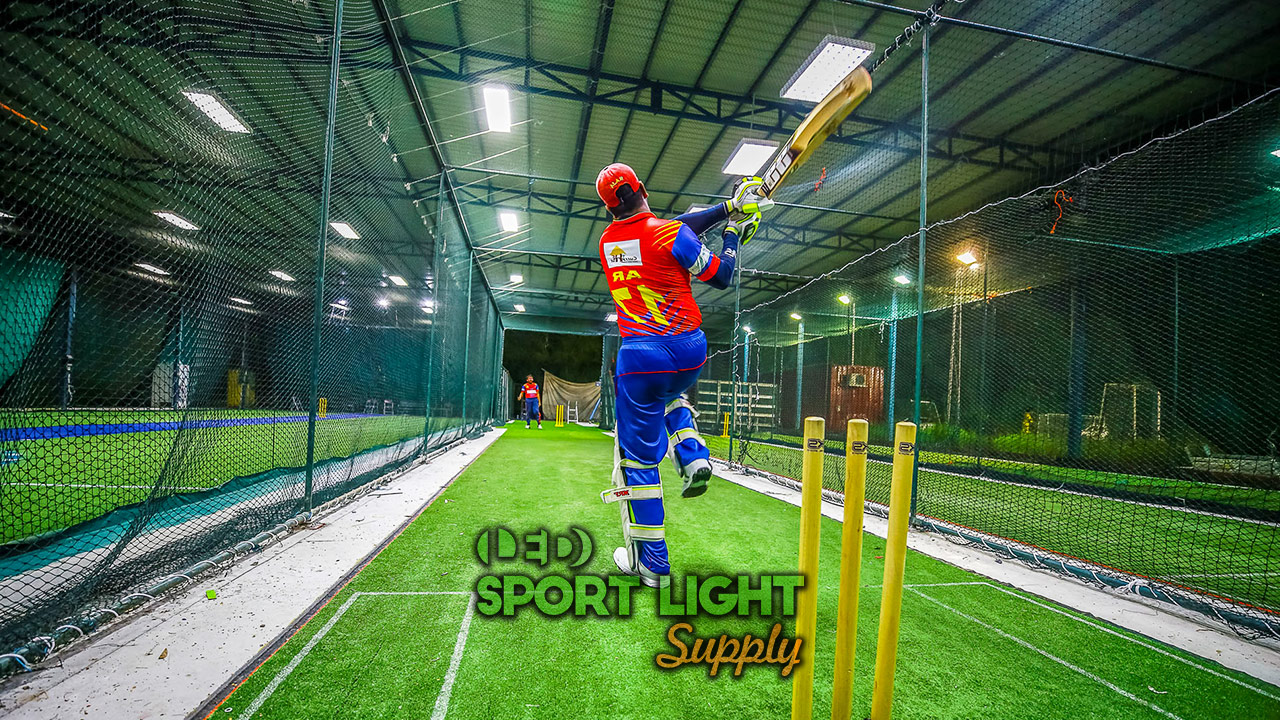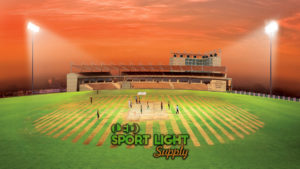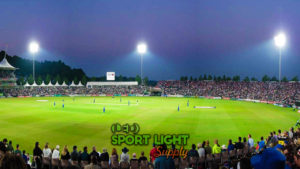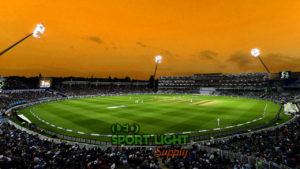An indoor cricket practice net must conform to precise lighting standards. Likewise, the lighting design for batting and bowling sessions responds to specific needs. Even the cricket court has its own recommendable lux level. Mostly, to ensure the players’ safety and security.
In this brief guide, you will find all the relevant criteria and indicators. In the end, you will know how to select the best indoor cricket court lights. But first, you will read about the different light sources used in an indoor cricket facility.
The importance of adequate illuminance will be discussed in the first part as well. Along with what cricket lighting standards and designs are all about.
What lights are used in indoor cricket practice net?
I have listed here two types of lights that you are going to find set up for an indoor cricket practice net.
In an indoor cricket center, most players go to practice what is easy for them regularly. For example, to keep their head on the batting strike rate. A bowling machine is usually set up to train the batter’s balance and response. And as you can imagine, the training session must get tough to help the player gain more confidence in their actions.
These lights are ideal for ensuring the players’ safety and vision.
1. High bay lights
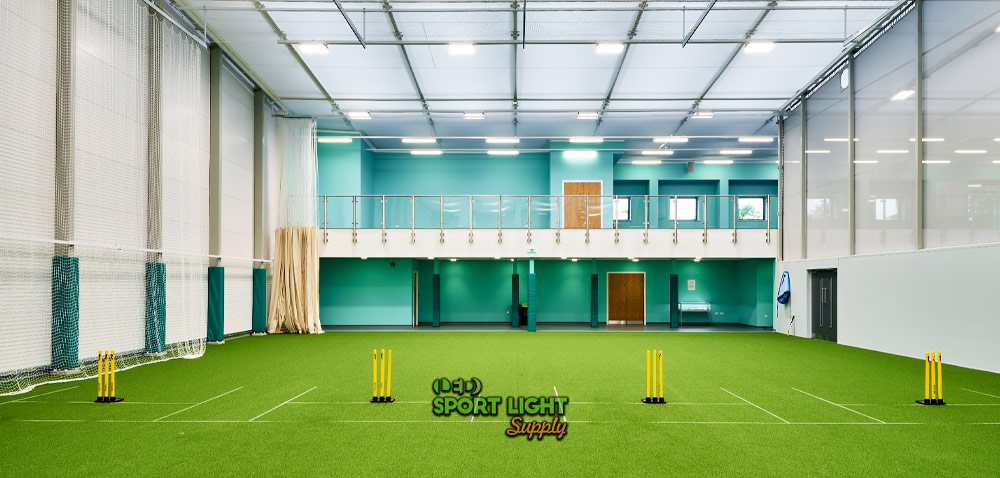
Think of them as super bright lighting fixtures designed for high ceiling installation. Generally speaking, high bay lights are maybe the most wide-spread light source in indoor cricket facilities.
In particular, LED high bay lights are extremely versatile. The light output and the price point are always on par or better than previous alternatives. Besides, you can install them on frames, gaskets, or just hang them from the ceiling.
The two most popular high bay light models are circular (UFO) and rectangular (linear) in shape. Above all, they are cost-effective, easy to install, and control.
2. High power flood lights
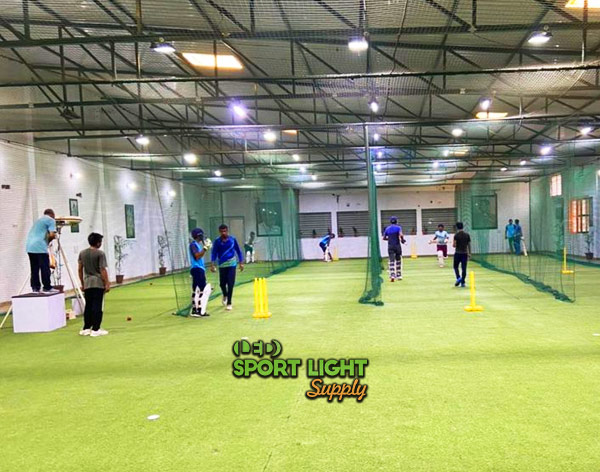 These traditional fixtures give you a large beam angle for broad coverage. Common wattage includes 400W, 1000W, and 2000W LED models. Just off the bat, they are easy to wire up virtually anywhere.
These traditional fixtures give you a large beam angle for broad coverage. Common wattage includes 400W, 1000W, and 2000W LED models. Just off the bat, they are easy to wire up virtually anywhere.
LED flood lights do not produce much heat and are usually light-weight. But you can mount extra accessories that can make them weigh more, like a glare shield. You can mount them on a tripod for extra brightness and to make a DIY portable lighting solution. Overall, a few high power flood lights are perfect for illuminating an indoor cricket practice net.
The main difference between flood lights and high bay lights is the way you use them. Flood lights can be installed at a vertical angle. On the other hand, high flood lights provide a more standard downward illumination.
Importance of indoor cricket ground lights
The main goal of a lighting design is to provide enough illuminance for training and playing. Moreover, the correct installation of indoor cricket ground lights is convenient. It ensures the maintenance of the suitable lux level.
As you are going to see, you have to follow a recommended lighting standard even for lighting up the practice net. But first, here are three central reasons why you should be aware of the indoor lighting conditions. Because if you are a cricket coach and you want your players to improve, you will have to step up your training sessions.
1. Nonstop cricket practice
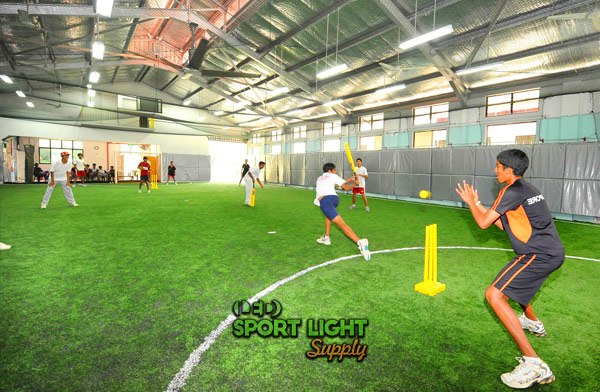 From a tech point of view, these lights let you maximize the use of cricket practice net. Simply put, LED is a reliable, stable light source. It can even work 24/7 and allow for nonstop cricket practice in indoor stadiums and sports facilities for different cricket clubs.
From a tech point of view, these lights let you maximize the use of cricket practice net. Simply put, LED is a reliable, stable light source. It can even work 24/7 and allow for nonstop cricket practice in indoor stadiums and sports facilities for different cricket clubs.
Working on the acquisition of several skills can mean having to turn on and off the lights in one area or another. LED lights let you brighten up the cricket net or the cricket court at will. Plus, you do not have to wait for them to cool down or to reach the max light output.
2. Improve cricket player’s vision
When you enter the cricket practice net, the bowling machine can throw you a fast-moving cricket ball, up to 160 km/h. That is just about the max speed that a top-level bowler can reach playing an international match.
Then again, Shoaib Akhtar breached the 160 km/h mark in 2003. So, the batsmen need to see the ball clearly coming at them in both the indoor practice net and the cricket court. If you use a combination of flood lights and high bay lights, you will achieve better luminance and cover all the possible angles.
3. Security
When you keep the indoor venue well lit, you also prevent trespasser and bad people in general from accessing the building. Every coach or high school representative needs to consider the various threats that come with a security breach. For example, young students want to play without having to worry about non-players accessing the outfield.
The lighting design should also consider emergency exits. As you can imagine, it is critical to illuminate the safe areas for a correct evacuation. Besides, staff or players standing too close to the cricket net could also be in danger.
What are the indoor cricket practice net lighting standards?
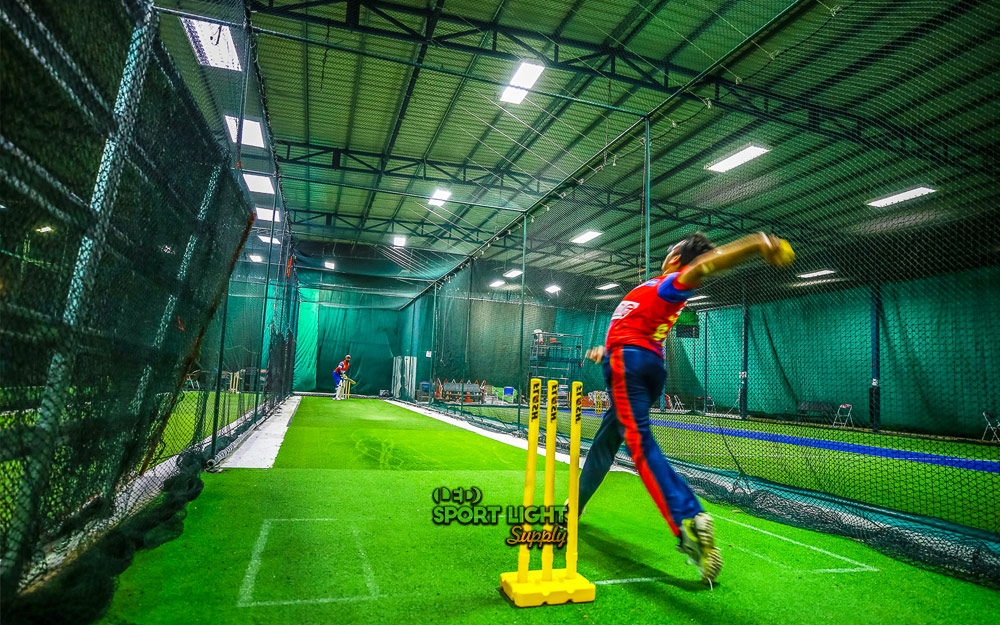
In this section, the discussion focuses more on the actual rules for lighting the indoor cricket practice net and field. More professional than amateur players know the following statement to be true. The higher the level, the brighter the lights. That is, the lighting standards require you to apply varying settings depending upon the level of play.
As you can see, you are going to read the top five requirements for indoor cricket activities. These rules apply to both training and games to prevent injuries and poor lighting issues. Lastly, they suppose you use the appropriate equipment to assess the quality of the lighting.
1. Lux & footcandle level
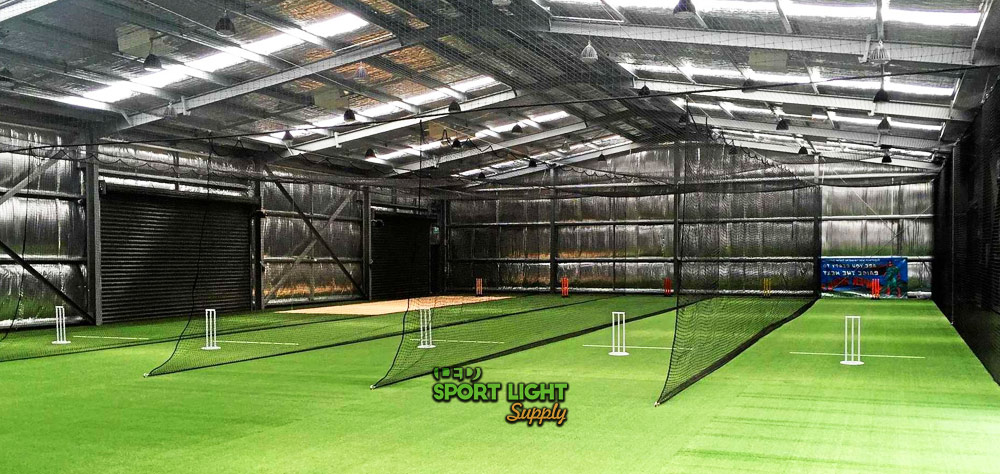
Most lighting recommendations follow an international standard. For example, the European Standard EN 12193. More likely, you will have to satisfy one of three levels of lighting:
- The first is for low-level club matches and activities.
- The second is for regional competitions and standard cricket clubs.
- The third is for national and international competitions and events.
Each level of lighting corresponds to a lighting class. But more importantly, each class uses a precise quantity of light intensity (brightness). In detail, the light intensity is measured by the lux (in the SI system, 1 lux is the basic unit of measurement for brightness) or footcandle (1 footcandle = 10.76 lux)
So, these are the lux and uniformity values for each class:
- I = 750 Lux (69.70 footcandles)
- II = 1000 Lux (92.93 footcandles)
- III = 1500 Lux (139.40 footcandles)
2. Lighting uniformity
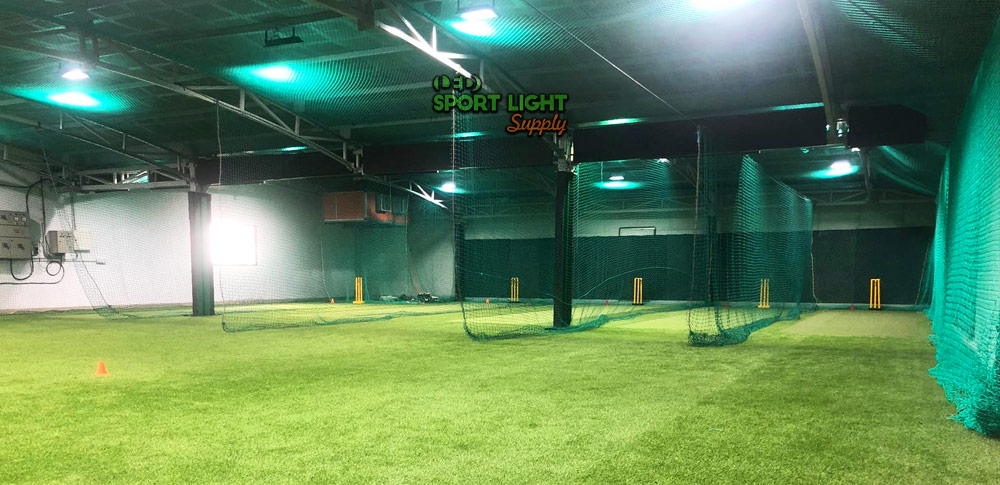
Uniformity is another way to say light distribution. In detail, you need both vertical and horizontal uniformity. After all, the goal is to see the cricket ball clearly.
The distance between the light sources and the different areas is also crucial. When you walk all around the cricket court, the uniformity changes.
When you place several high bay lights or flood lights, you need to make sure that every area is well lit. So, you sample each part of the cricket court or even the cricket net with a specific tool, a lux meter. After you do that, you find out the uniformity values.
A lighting grid is used to create the sampling points. For indoor cricket activities, uniformity must be 0.8. In this case, the uniformity is the ratio between minimum and average lux values.
3. Ceiling height of a practice net
When a batter strikes the ball, things can get messy pretty fast. So, the ceiling height of the practice net must be at least 4 to 5 m. In this way, a sufficient height guarantees high light uniformity and reduces glare.
Smaller distances can represent a problem for any batter trying to hit the ball as hard as he or she can. Besides, the ceiling height is often in relation to the inner spacing and length of the hall.
It is always better to have at least 4 meters to let bowlers practice the run-up. Then again, if you put on cricket net blinkers, you need enough space to still provide an adequate illuminance.
4. Color temperature
Since most indoor cricket court lights are LED fixtures, this means that you can select or choose the color temperature. That is, how the light looks like.
When you go buy LED bulbs, you might have seen a Kelvin value on the package. That is the color temperature. In detail, a scale of degrees Kelvin (symbol K) expresses the shade of light and its color.
For several reasons, you should pick light fixtures with a color temperature above 5000K. But, you should not go too far and choose a 6500K because this hue tends to be too bluish.
5. Background contrast
If you noticed how the paint on the wall reflects the light, then you know that reflected light can even blind you. Probably, you would argue that white is the more reflective color. In this case, you would be totally right. But broadly speaking, light-colored walls have better reflectance.
An indoor cricket facility must consider this parameter as well because it creates more contrast. Background contrast is critical with both daylight and artificial light sources. So, the reflectance value should be between 0.3 and 0.6 for the walls and between 0.6 and 0.8 for the ceiling.
Indoor Cricket ground and practice net lighting design and layout
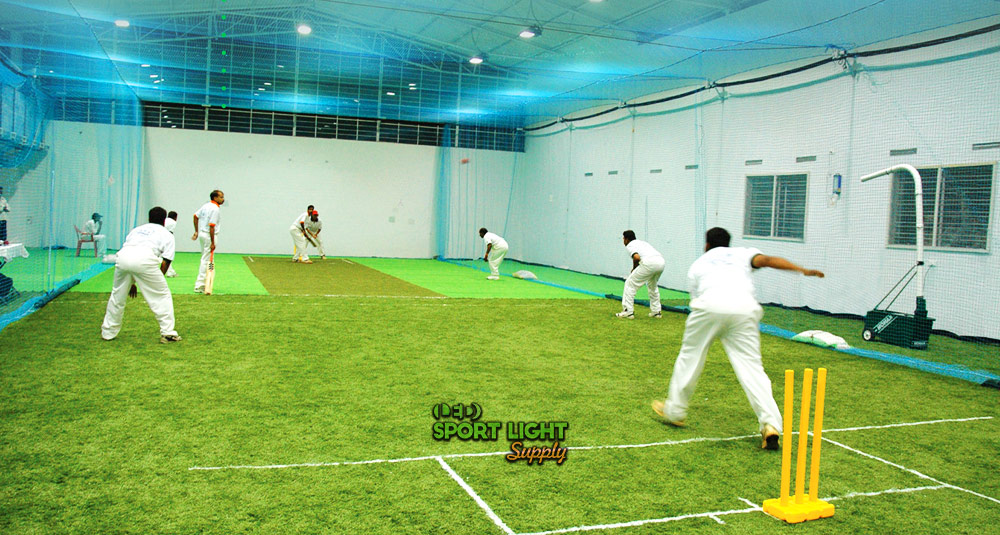
Safety and comfort are the two most cherished values when planning the lighting design and layout. So, let us dig deeper into the actual rules that make a lighting design for an indoor cricket ground great.
First, you are going to find out the importance of the installation height. Some details on the distance between the high bay lights will follow next. Finally, the wattage and type of ceiling will be the center of our attention.
1. Installation height
In any cricket facility, you do not want the lights to hang so low that players can bump their heads into them. At the same time, the overhead spacing should maintain lighting uniformity while preventing glare.
The exact distance will depend on the quality of the high bay lights or flood lights. Furthermore, whether you plan to install fixed or hinged light fittings. The ultimate goal is to achieve the recommended lux level. So, you need to figure out this distance with the help of an expert or the right equipment.
2. Distance between the high bay lights or flood lights
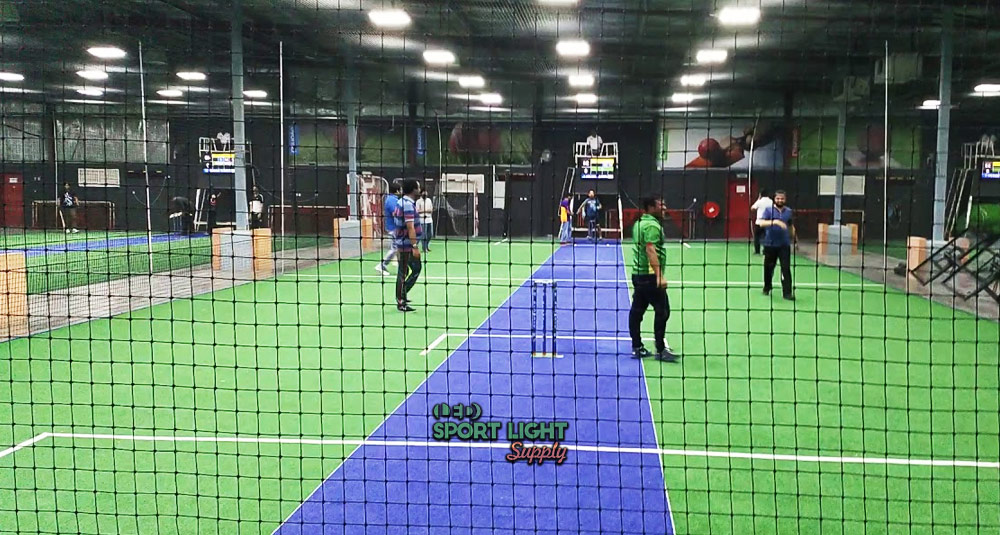
Depending on beam angle and ceiling height, you can expect to use a 5 to 10 feet (1,5 to 3 meters) distance between the light fixtures. The court format could help in creating a custom light design with different solutions.
Usually, a club should consider a number of lanes to train several players using cricket nets. Many light sources should illuminate the indoor cricket court to reduce glare and keep the illuminance level. A minimum light to sidewall margin should be kept for the same purpose as well.
3. The wattage of indoor cricket net lighting
With so many LED models on the market, you will have plenty to choose from. Most likely, you will end up needing 400 to 2000 watts, depending on the lux required.
The main problem with giving a precise watt estimate lies in the lumen per watt ratio. In fact, you do not calculate the necessary watts as much as you figure out the required lumen output. It all comes down to how you get a lux. That is, understanding what a lumen is and how many lumens you need to reach the lux level of your level of play.
4. Vaulted ceiling or flat ceiling
Flat ceilings let you plan a lighting design with fewer issues. In detail, you can use a ceiling mount, install a frame, or hang the high bay lights.
By contrast, you need to use smaller beam angle fixtures at the edges of a vaulted ceiling (lower part of ceiling). Plus, larger beam angle fittings at the center of it (higher part of ceiling). This also means a low power output at the edges and a higher one at the center of the vaulted ceiling. In the end, you still need to check with a lux meter and make the necessary adjustments.
How to select the best indoor cricket court lights
Once you figured out the general design objectives, it is time to choose the lights. But to get the most useful indoor cricket net lights, you need to consider at least seven essential factors. These factors will let you find the most appropriate products for your venue. Plus, they will help you understand how to spend your money more wisely.
When you read the specs, this data let you forecast the product performance. So, I have gathered the most useful specs you need to know to get you more bang for your buck.
1. Luminous efficacy
Without getting too technical, you should search for lights with at least 130 lumens per watt. In the cricket practice net, you need adequate levels of light. But you may also have to move the cricket net from time to time. Especially if your sports facility hosts several community events.
Such a lumen per watt ratio offers you the best compromise and versatility. You still get a high-quality light source at a low price. Meanwhile, you can set up multiple lights all over the ceiling to follow the illuminance level and its uniformity standard.
2. Life span
If you are planning to make savvy purchases, then you should consider buying LED flood lights or high bay lights. On average, the life span of a light source depends on factors like usage and overheating.
The most traditional light sources have terrible life spans. That is because they overheat easily and need to cool down before turning them on again. Instead, if you pick LED lights, you can expect the lights to last for over 150,000 hours. Of course, the manufacturer must still provide quality certifications and warranties. But overall, LED lights are the most long-lasting products available.
3. Beam angle
When considering the beam angle, you should include other project specs that may not be exclusively related to the cricket court. For example, you should think of public and emergency lighting, as well as ancillary lighting, uses. For this reason, I would suggest you get 60 or 90 degrees beam angle fixtures.
In this way, you can easily use accessories to reduce the beam angle while still using them for the cricket net when necessary. Or vice versa. Among all, LED flood lights are the most versatile light fixtures as you can move them fast.
4. Glare control
A whole set of accessories and specs are devoted to glare control. For example, many luminaries have reflectors, lenses, or anti-glare louvers to reduce or prevent glare.
The main issue with glare is that it is not a problem that only relates to the player during practice. In fact, spectators can suffer from discomfort glare when looking at an indoor cricket match. So, it is useful to consider the shape and type of your lights to create luminaries rows aligned with the pitch axis. That is why you need more light points in the cricket facility.
5. Independent control
Since the practice net is divided into different individual nets/parts, you can use DMX or DALI system to group the lights. In this way, you can only light up a cricket practice net at a time. Of course, this solution lets you save energy and thus running costs.
DMX and DALI are two protocols used to control the lighting system. You will also need a control module or controller for DALI and DMX systems. That is, a converter and bus tool for local command. Possibly, to control both systems in more advanced indoor stadiums.
6. Direct or indirect lighting
Make a note of the type of lighting you want to achieve. For starters, you can begin by choosing direct or indirect lighting. Direct means the light sources point downward to light the practice net directly. By contrast, indirect means the light fittings point upward to the ceiling. Basically, you use the reflected light to light the net.
Overall, indirect lighting has better lighting uniformity but consumes more energy. Instead, direct lighting can cause glare and may require the use of extra anti-glare accessories.
7. Emergency lighting
Emergency lights are critical in case of lighting failure. Plus, many associations’ lighting standards ask you to consider or follow some rules about emergency lighting. In fact, you need to cover both training and match practice areas. You also should have a set of lights ready to guide the spectators out of the facility.
In other words, it is not only the cricket court or pitch that needs emergency lights. So, remember to get some fixtures to comply with the International Building Code. These lights can be useful during maintenance repairs as well.
LED replacement of metal halide, mercury, and halogen cricket ground lights
In case you do not know what light fixtures to buy, here are the advantages of using LED lights to replace more conventional fittings for the cricket ground.
Of course, when the facility needs the complete replacement of the lighting system, LEDs are the obvious choice. After all, they let you save on the electricity bill while keeping all the other specs.
If you need to retrofit your system, LED products are more manageable. You do not have to convert the fitting or module for each lamp. Or, more accurately, you do not have to fix the wiring or remove the high-voltage ballast once you installed LED lights.
With LED, you do not have to deal with dangerous metals like mercury being a problem. At the same time, you get a product with a huge life span. This means you will not have to replace them continuously.
1. Better energy efficiency
The chief benefit is that you can use smaller wattage to achieve the same brightness. Simply put, the equivalent light output of LED cricket lights will cost you less than the replacement of each fitting with a similar bulb.
Their energy-saving feature also means less heat and no disposal issues. In short, the LED produces heat, but it dissipates in the rear of the fixture through the heat sink. Then, when the LED cricket net light dies, you simply take them to a recycling facility or put them in the standard trash.
2. Longer life span
Because they produce less heat, they will last longer. Any cricket court LED light has a longer life span than the other lamp types. In detail, if you compare LEDs with Metal halide lamps, LEDs last more than ten times as much, according to the official tests. This proportion is even bigger if you compare LED to halogens. Mostly because each halogen bulb lasts 2000-6000 hours at best.
3. More flexible lighting control
The latest cricket court LED lights come with smart wireless control. For example, smartphone control, DMX grouping, Bluetooth connection, etc.
Previous lighting techs do not include such luxury. But it is not merely a trend, as the lack of these tools means the incapacity to change the lights instantly. You cannot control the brightness or adjust the illuminance to the level of play. Finally, converting to LED lights adds a more flexible lighting control system. One that lets you monitor the light source performance individually.
4. Cooler
Here is a final perk of low heat emission. LED lights do not generate much heat, and thus the cricket players can feel more comfortable. In fact, they reduce the cost of air conditioning. So, you kill two birds with one stone, or conversion, in this case.
Conclusion
We touched upon all the relevant info about indoor cricket practice net lighting to help you understand and select the best fittings. Now you know even more about indoor cricket court lights than most cricket coaches do. And you are prepared to do your own research as well.
As you find more data and specifications on the lighting standard you need to follow, more data could be necessary. But luckily, you can always count on experts like us to give you precious suggestions and clarifications. So, do not hesitate to get back at reading some of these guide parts or reach out for more answers.

